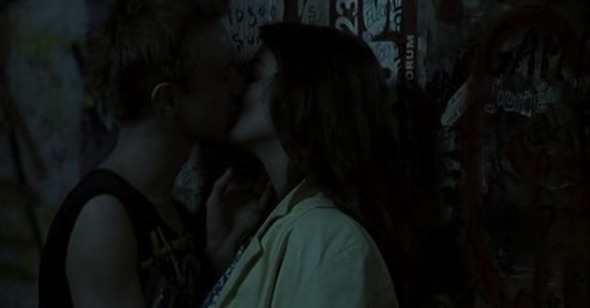Disorder (1986)
With films like demonlover, Cold Water, and Irma Vep crowding the field, it’s possible to look back over Olivier Assayas’s career and miss his first feature, Disorder, completely. True, it did win the Critics’ Prize at Venice, but it still feels like more of a footnote than a jumping off point for the work that was to follow. Three friends, Yvan, Remi, and Xavier form the core of a struggling post-punk band in need of equipment. Taking a cue from the Sex Pistols legend (but minus Rod Stewart), they burglarize a local music store, and are caught by the store’s owner. In the ensuing fight, the owner is killed, and for the rest of the film, the friends are left to carry their guilt. While not at all under suspicion for the random act, its weight presses down on them, creating paranoia, and eventually destroying their friendship. Disorder is cast in an aura of overall gloom, partly due to a silver retention process used to treat the footage, but perhaps more because Assayas, even within the constraints of this simple narrative framework, seems to be channeling Dostoevsky’s sensitivity to moral quandary into a compressed torch song by Ian Curtis.
Winter’s Child (1989)
This may sound horribly reductive, but Disorder and Winter’s Child seem proof positive that most great filmmakers are made, not born. There’s no sense in this pair that we are watching the work of a filmmaker completely in command of the medium. Rather, we can locate a certain fascinating restlessness that results in equal parts rough edges and moments of near-greatness. How else to explain Winter’s Child’s quiet, Bergman-esque formalism, which almost feels the work of a different filmmaker? It’s the story of a love quadrangle, a child, a theater troupe, and a long winter, that feels like a warm-up to the overwhelming, complicated intersections in Late August, Early September. Nathalie is pregnant, but the baby’s father, Stefane, leaves her for Sabine, a set designer for the theater. Sabine has just left Bruno, an actor in the same troupe. Nathalie tries to kill herself and is saved by her friend Leni, as Stefane then follows Sabine on her theatrical tour. If it sounds overly complicated, it is. However, though it may be tempting to view these early films only as stepping stones on the path to the filmmaker Assayas has become, to do so would be to ignore small pleasures offered when taken in their own right.
Paris Awakens (1991)
And yet, it moves. Like Winter’s Child and Disorder, Paris Awakens was shot by Denis Lenoir, and it is here, in the culmination of this rough trilogy exploring rites of passage that their collaboration bears its first ripe fruits. Those who became acquainted with Assayas through Irma Vep (though shot by Eric Gautier) or Late August, Early September were treated to films conceived as perpetual motion machines—the camera as a restless roving eye that forces even the calmest of scenes into a certain level of velocity. In this story of an estranged son who holes up with his father (and what a father—played by Jean Pierre Léaud), and ends up stealing his much younger girlfriend, Louise (Judith Godriche), the camera is in motion from the very first shot. For me, it’s most memorable for what I find the first truly “Assayas” moment in his cinema. Midway through the film, a familiar bass-line snakes its way into the end of a quiet, spinning love scene. We fade to black and cut to Louise who picks up the camera’s rotation through a crowded dance club floor just as the unmistakable guitar riff of the Pixies’ “Debaser” takes up the call. The camera allows Louise to dance well into the song before cutting to Léaud and a few older friends trying in vain to converse over the music. Rock ‘n’ roll, generation gaps, dance as catharsis (look for it again in Cold Water, Irma Vep, Les Destineés, and demonlover)—it all starts here.
Une nouvelle vie (1993)
Paris Awakens was a gigantic leap forward—the apartment that housed most of the film’s action, turned into a battlefield by a camera constantly prowling its confines, showed a filmmaker coming into his own. Une nouvelle vie (not to be confused with the recent, similarly titled abomination by Phillipe Grandrieux), Assayas’s first film shot in ’Scope, takes these advancements and ties them to a radical formal strategy. For this, his fourth feature, he wrote and shot a three-hour film. However, while editing, he removed a full third of the narrative. The result is full of scene transitions that feel like explosions threatening to rip the narrative to shreds. If Bresson was a point of reference before, here these elisions and a persistent interest in character’s midsections and hands announce Assayas as perhaps his true heir. Tina (Sophie Aubry), stifled at home by her mother, at work (she drives a forklift) by gender pressures, and in love by her almost-fiancé Fred seeks a new start by reaching out to the wealthy father she’s never known and half-sister, Lise (Judith Godriche). She finds in turn, anger, casual disinterest, understanding, eventual kinship with Lise, and a lover in the form of Bernard Girardeau’s slick lawyer, Clemintin. Never released in the U.S., Une nouvelle vie deserves to rank alongside his later, more celebrated works—his first true poem of the working world fully and finally sets the stage for the other Assayas to take over, the one who just may well be one the leading lights of world cinema today.
